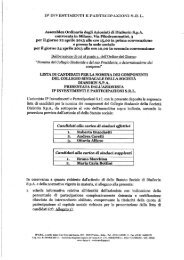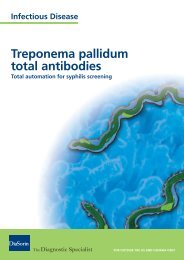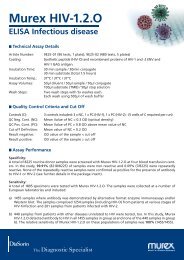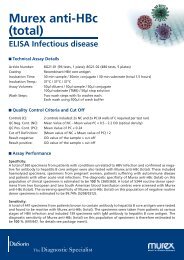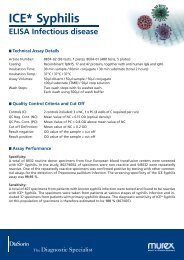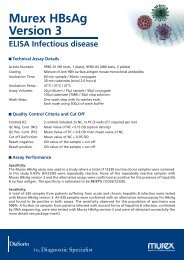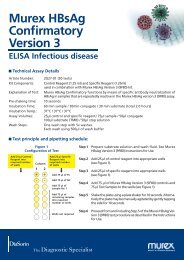Syphilis Booklet - DiaSorin
Syphilis Booklet - DiaSorin
Syphilis Booklet - DiaSorin
You also want an ePaper? Increase the reach of your titles
YUMPU automatically turns print PDFs into web optimized ePapers that Google loves.
Table 8: Characteristics<br />
of direct diagnosis<br />
• If positive:<br />
• Immediate diagnosis<br />
• Very specific<br />
• Very early: even prior<br />
to seroconversion<br />
• If negative:<br />
• Serology is required<br />
• False negatives:<br />
• When only a few treponemes<br />
are present<br />
• Due to previous topical<br />
or systemic treatments<br />
very useful in congenital syphilis where<br />
antibody transport can affect the diagnosis, in<br />
neurosyphilis 27 for which VDRL features 50%<br />
sensitivity and in early primary syphilis without<br />
seroconversion. 28<br />
2.1.5. Placental histopathology<br />
Study of the placenta significantly increases<br />
the number of diagnoses performed on fullterm<br />
infants and to a lesser extent on<br />
premature and stillbirths. 30<br />
2.2. Indirect diagnosis: serological<br />
tests<br />
Serological diagnosis is the laboratory tool<br />
used the most to diagnose this infection.<br />
Reaginic tests detect non-specific treponemal<br />
antibodies (Cf. Table 9), while treponemal<br />
tests measure specific antibodies. They should<br />
preferably be conducted in serum. Each is<br />
complementary to the other and their<br />
prediction value is optimised when performed<br />
simultaneously. They are also necessary to<br />
support treponeme visualization diagnosis.<br />
2.2.1. Reaginic tests<br />
Several different techniques have been used<br />
to diagnose syphilis ever since 1906, when<br />
Wassermann et al. adapted the complement<br />
fixation test. The historical development of<br />
these tests reflects the extreme importance of<br />
this disease in the past. 16<br />
All these tests use alcohol antigen solutions<br />
containing standard mixtures of purified and<br />
stabilised cardiolipins, cholesterol and<br />
lecithins. Together, they measure the serum<br />
level of IgG and IgM immunoglobulins against<br />
substances in inflammation and/or<br />
treponemes damaged tissues. 1,4<br />
They can be used qualitatively or<br />
quantitatively. Quantitative tests are the most<br />
informative as they set a reference for<br />
reactivity measured versus biological changes<br />
during infection, natural evolution or after<br />
treatment. All reaginic test procedures have<br />
approximately the same sensitivity and<br />
specificity but reactivity expressed as serum<br />
titre can vary according to antigen quality. The<br />
same reagent batch should therefore be used<br />
for all titration samples when comparing<br />
titres. The following techniques are the most<br />
widely used for diagnosis.<br />
2.2.1.1. VDRL (Venereal Disease Research<br />
Laboratory)<br />
This test can be applied on serum or plasma<br />
and the sample may not require heating<br />
according to the brand used, as well as on unheated<br />
CSF. The reaction obtained with a<br />
positive sample is flocculation with a nonparticulate<br />
antigen, so microscopy should be<br />
used for reading. Test results are largely<br />
subject to proper procedure completion and<br />
all parameters involved should be controlled<br />
by following all related reagent preparation<br />
and use instructions. The test measures both<br />
IgG and IgM antibodies simultaneously.<br />
2.2.1.2. RPR (Rapid Plasma Reagin)<br />
Plasma and serum may be used. This method is<br />
a variation of VDRL, in which carbon particles<br />
are added to VDRL to facilitate macroscopic<br />
flocculation reading. The commonest method<br />
uses an 18-mm round plate as a test base. This<br />
method should not be employed with CSF.<br />
The patient’s sample is mixed in both tests with<br />
the antigen in a preset diameter circular vessel.<br />
All antibodies present match up and cause a<br />
reaction read microscopically at 100<br />
magnification in the case of VDRL, or<br />
13



